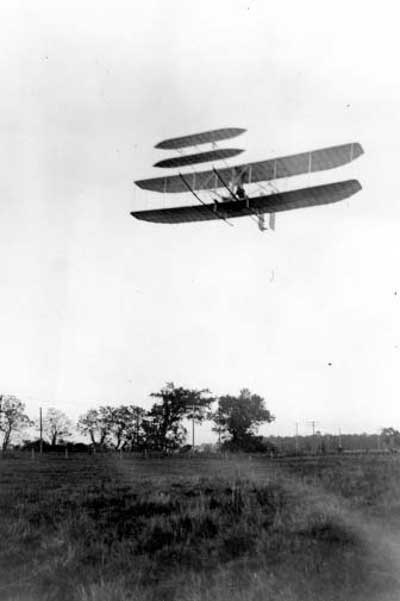- Wright Flyer III
Infobox_nrhp | name =Wright Flyer III
nrhp_type = nhl

caption = The Wright Flyer III in flight overHuffman Prairie ,4 October ,1905 . Note the pilot is still in a prone position which would not be changed by the brothers until 1908.
location=Dayton, Ohio
lat_degrees = 39
lat_minutes = 43
lat_seconds = 40
lat_direction = N
long_degrees = 84
long_minutes = 12
long_seconds = 7
long_direction = W
locmapin = Ohio
area =
built =1905
architect= Wright,Orville; Wright,Wilbur
architecture= Other
added =June 21 ,1990
governing_body = Private
refnum=90001747cite web|url=http://www.nr.nps.gov/|title=National Register Information System|date=2007-01-23|work=National Register of Historic Places|publisher=National Park Service]The Wright Flyer III was the third powered
aircraft built by theWright Brothers .Orville Wright first flew the Flyer III on23 June 1905 . The Flyer III had a new airframe of spruce construction with a wing camber of 1-in-20 as used in 1903 rather than the less than ideal 1-in-25 used in 1904. The new machine used the propulsion system from the Flyer II, and was essentially the same design and same performance as Flyers I and II.Modification
When rebuilding the Flyer III after a severe crash on
14 July 1905 , the Wrights made radical changes to the design. They almost doubled the size of the elevator andrudder and moved them about twice the distance from thewing s. They added two fixed vertical vanes (called "blinkers") between the elevators, and widened the skid-undercarriage which helped give the wings a very slightdihedral . They disconnected the rudder of the rebuilt Flyer III from thewing-warping control, and as in most future aircraft, placed it on a separate control handle. When testing of Flyer III resumed in September the results were almost immediate. The pitch instability that had hampered Flyers I & II was brought under control. The crashes, some severe, which the Wrights had experienced disappeared. The flights with the redesigned Flyer III started lasting over 20 minutes. Thus Flyer III became a practicable, as well as dependable aircraft, flying solidly for a consistent duration and bringing its pilot back to the starting point safely and landing without damage to itself.On5 October 1905 , Wilbur flew 24 miles (38.9 km) in 39 minutes 23 secondscite book | title=Biplanes, Triplanes and Seaplanes | id=ISBN 1-58663-300-7 | last=Sharpe | first=Michael | publisher=Friedman/Fairfax | year=2000 | page=311 ] , longer than the total duration of all the flights of 1903 and 1904. Four days later, they wrote to theUnited States Secretary of War William Howard Taft , offering to sell the world's first practical fixed-wing aircraft.Flying at Kill Devil Hills
Disassembled on
7 November 1905 , they refurbished it as the 1908prototype of their new Model A aircraft. This two-man carrying version of Flyer III was flown south of Kitty Hawk from6 May to14 May 1908 . These flights in the reconfigured Flyer III served as a means for Wilbur and Orville to test the new controls and also the passenger-carrying abilities of the aircraft. OnMay 14 1908 Wilbur took up mechanicCharles Furnas in Flyer III, making Furnas the first passenger the brothers ever flew. Orville also flew with Furnas for four minutes. Later that day, Wilbur was flying solo when he pulled one of the new control levers the wrong way and crashed into a sand dune. Only the front elevator was damaged but the brothers had to move on to newer aircraft.Preservation
Flyer III was left in the hangar there at Kitty Hawk unrepaired. In 1911 the Berkshire Museum of Pittsfield, Massachusetts obtained parts of the disassembled aircraft and the 1911 Wright glider, but never assembled or exhibited them. These parts of the 1905 aircraft remained in Massachusetts for almost forty years until Orville requested its return in 1946 for its restoration as a central exhibit at
Edward A. Deeds ' Carillon Park in Dayton, Ohio. Some Kitty Hawk residents also possessed pieces of the 1905 airplane; Deeds and Orville also obtained many of these for the restoration. At the end of the 1947-1950 restoration process, restorers estimated that the 1905 aircraft retained between 60 and 85% of its original material. The 1905 airplane is now displayed in theWright Brothers Aviation Center atCarillon Historical Park inDayton, Ohio and is a component ofDayton Aviation Heritage National Historical Park . The restored 1905 Wright Flyer III is the only fixed-wing aircraft to be designated aNational Historic Landmark by an act of Congress.pecifications (Flyer III)
[

Ohio 50 State Quarter features the 1905Wright Flyer III built and flown in Ohio, as shown in the famous photo fromHuffman Prairie ] aircraft specifications
plane or copter?=plane
jet or prop?=prop
ref=Sharpe, 2000. p 311.
crew=one pilot
capacity=one pilot
length main=28 ft 0 in
length alt=8.54 m
wing camber=1-in-20
span main=40 ft 4 in
span alt=12.29 m
height main=8 ft 0 in
height alt= 2.44 m
area main=503 ft²
area alt=46.8 m²
empty weight main= lb
empty weight alt= kg
loaded weight main=710 lb
loaded weight alt=323 kg
max takeoff weight main=710 lb
max takeoff weight alt=323 kg
engine (prop)= water-cooled, 4-cylinder inline engine 20 hp 14.9 kW,
type of prop= two Wright elliptical propellers later changed to two Wright "bent-end" propellersmax speed main=35 mph
max speed alt=56 km/h
range main= 25 miles (as of October 1905)
range alt= km
ceiling main= 50 to 100 ft (as of October 1905)
ceiling alt= m
climb rate main=ft/min
climb rate alt= m/min
loading main=1.4 lb/ft²
loading alt=7 kg/m²
power/mass main=0.03 hp/lb
power/mass alt=0.05 kW/kgReferences
Bibliography
*
Related content
*Dayton Aviation Heritage National Historical Park, [http://www.nps.gov/daav]
* [http://www.first-to-fly.com/History/History%20of%20Airplane/mechanic.htm info. on mechanic Charles Furnas]
*Modern flying replica of [http://wright.nasa.gov/replica/rep1905.html Wright Flyer III]
Related
Wright Flyer II Similar Aircraft Sequence
Flyer I -
Flyer II -Flyer IIIWright Flyer 3 today
* [http://www.first-to-fly.com/History/Just%20the%20Facts/1905%20Flyer.htm preserved Wright Flyer III at Carillon Park]
Wikimedia Foundation. 2010.
